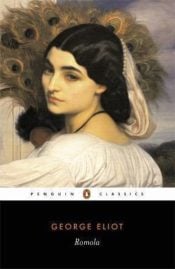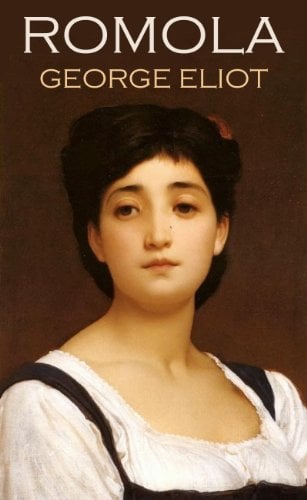Romola by George Eliot (1862)
By Taylor Jasmine | On June 17, 2017 | Updated October 19, 2022 | Comments (0)

Romola (1862– 63) is today perhaps the least known, and thus, the least read of George Eliot‘s novels. Yet in her lifetime it enjoyed much critical acclaim, though it was not a favorite of readers even back then.
Its dense language has tested the patience of readers from the time of its publication. But the author herself said of it, “I swear by every sentence as having been written with my best blood.”
The title character is the daughter of a scholar, and herself well educated, which was unusual for a women in the late 1400s and early 1500s, when the story takes place.
The novel follows her through several of these post-Medici years in Florence, a tumultuous time further ignited by Savanarola, a Dominican friar, and his preachings.
The following description is adapted from the 1961 J.M. Dent edition of Romola:
A tour de force, if not a masterpiece
The Florence of Savonarola — a world of vibrant life, evil, and tumult overshadowed by the dark figure of the great Dominican — is the scene of this unusual novel by George Eliot.
The novelist ‘of the commonplaces of contemporary life,’ whose observations were supported by such a wealth of imaginative thought and insight in Middlemarch and The Mill on the Floss, was not primarily suited by temperament to write a historical novel.
But, as the introduction to the 1937 edition states, ‘if Romola is not her greatest achievement it is her greatest tour de force; if it is not perfectly a work of temperament it is a work of striking ability and of absolute sincerity.’
That the writing of Romola cost the author much we have from her own testimony: “I took unspeakable pains in preparing to write Romola — neglecting nothing that I could find that would help me to what I may call the “idiom” of Florence, in the largest sense one could stretch the world to.”
This ‘idiom’ can be found on every page — in the topography, the manners and customs, the art, the dress, the thought, and political of the time.
. . . . . . . . . .
. . . . . . . . . .
Lorenzo the Magnificent and the Republic of Florence
The action occurs between the years 1492 and 1498, most eventful years in the history of the Republic of Florence … At the opening of the story Lorenzo the Magnificent, one of the most notable members of the Medici family, is not yet dead.
His influence has spread in many directions, but as far as the first book of Romola is concerned, its general emphasis is laid on a phase of its influence, most to his renown, the the advancement of Greek learning.
The complex Savonarola
Savonarola was the overshadowing figure of Florentine life at that time, as he is the overshadowing figure of Romola.
And the complex qualities of the prophet and preacher, the statesman, and ecclesiastical ruler — the “mysteries,” as George Eliot says, “of human character have seldom been presented in a way more fitted to check the judgment of facile knowingness than in Girolamo Savonarola” — have never perhaps been so adequately illustrated and appreciated.
. . . . . . . . . .
More about Romola by George Eliot
- Wikipedia
- Reader discussion on Goodreads
- Romola: The George Eliot Fellowship
- Listen to Romola by George Eliot on Librivox
. . . . . . . . . .
See also: Middlemarch by George Eliot


Leave a Reply